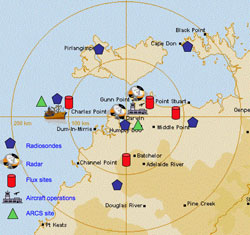Media Advisory
Media Contact: Lynne Roeder, 509.372.4331
Technical Contact: Mike Janes, 925.294.2447

The U.S. Department of Energy’s Atmospheric Radiation Measurement (ARM) Program invites news media to observe a team of 25 climate researchers from the United States, Australia, and the United Kingdom as they prepare to launch simultaneous ground, sea, and sky operations during the Tropical Warm Pool International Cloud Experiment this coming winter. Sandia National Laboratories, home to ARM’s Unmanned Aerospace Vehicle (ARM-UAV) program, is hosting the three-day simulation, where researchers will conduct weather briefings and mission planning to reflect actual field operations and flight scenarios during the complex experiment. News media are invited to observe the simulation exercises on Thursday, September 8, between 10 am and 4 pm, and talk with scientists leading the experiment.
WHAT:
Mission Planning and Flight Operations Simulation
WHO:
Jim Mather, ARM Program
Peter May, Australian Bureau of Meteorology
Will Bolton, ARM Unmanned Aerospace Vehicle Program
WHEN:
September 8, 2005
WHERE:
Sandia National Laboratories
7011 East Avenue, Livermore, California
Building 905, Room 209
Please call for directions or visit http://www.ca.sandia.gov/Ca-site/site_area.html. Visitors must call ahead to arrange for badging.
The experiment, organized jointly by the ARM Program and the Australian Bureau of Meteorology, begins in January 2006, in the region around Darwin, Australia. It will involve the use of atmospheric sensing equipment located at multiple ground stations, on a ship operating off the coast, and on an instrumented fleet of aircraft. Data collected during the month-long experiment will be used to validate and improve cloud and global models for climate change research and for assessing the environmental impacts of tropical monsoons.
# # #
The ARM Climate Research Facility is funded through the U.S. Department of Energy’s Office of Science. Additional information about ARM Program Science and the ARM Climate Research Facility is available at www.arm.gov.

